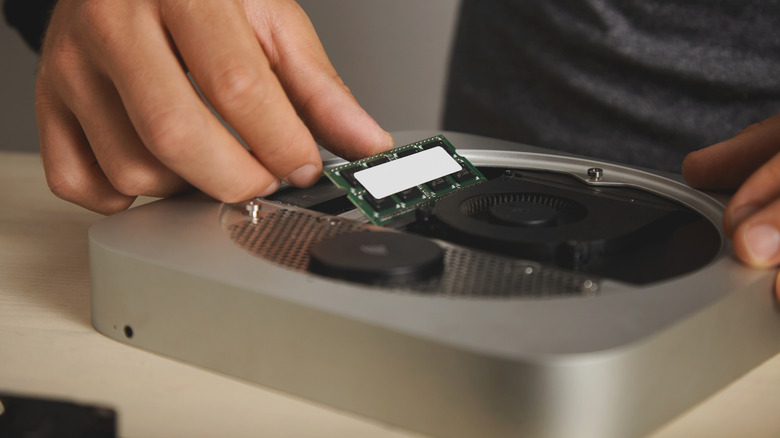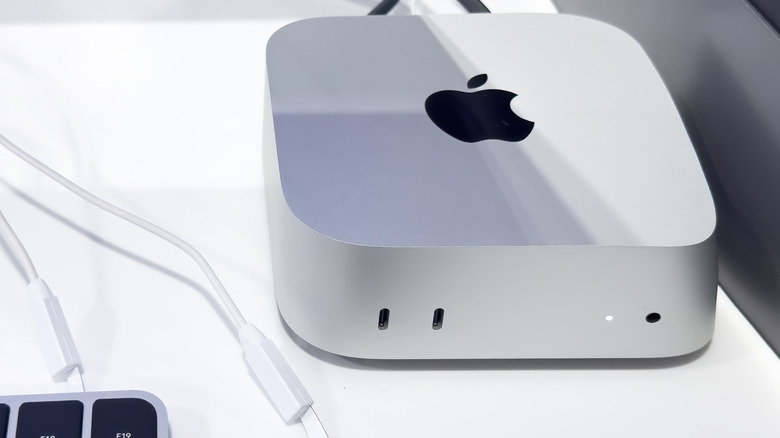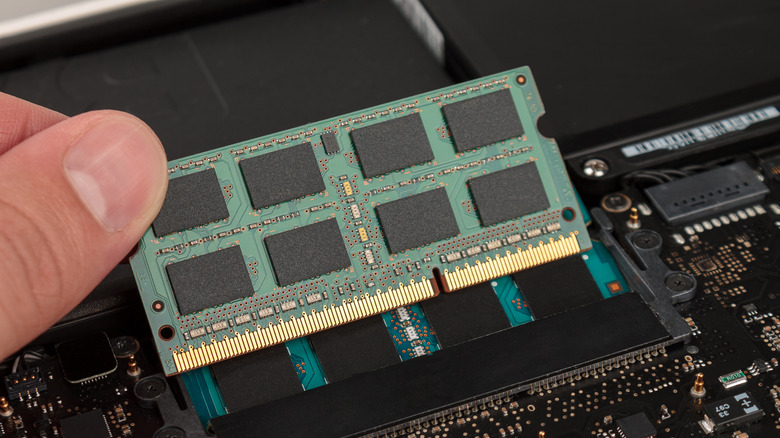Can You Upgrade Your Mac's RAM At Home? Here's What You Need To Know
If there's one component that's underrated for the massive impact it can have on your computer's speed, it's the RAM. RAM stands for random access memory, which is basically where your computer stores short-term data it's currently using. When you have a large pool of RAM, you can open more apps at the same time, multitask all you want, and experience a smoother overall performance.
The problem, though, is that the more memory a computer has, the higher its price goes. So if you're on a budget, you'll probably just buy a lower-memory model or two. But what if, down the line, you discover that your current RAM size isn't enough for your needs? Perhaps you only have 4GB of RAM but are often editing videos or doing research with multiple apps and browser tabs opened. In that case, would you need to buy an entirely new computer with more memory?
Lucky for you, you don't necessarily have to. If you have a Mac, you can simply upgrade its RAM at home instead. Yes, some Mac models have easily upgradable RAM, and all it takes is a quick disassembling to replace the modules.
Which Mac models have upgradable RAM?
One of the things to know before buying a MacBook or any other Mac product is that upgrades are next to impossible. Generally, for the more recent releases, you can no longer upgrade your Mac's RAM at home since it's either soldered onto the board or integrated into the M chip. There are still some Mac models that allow you to change the RAM sticks yourself, though.
For instance, all the 13-inch MacBooks from 2006 to 2010 come with RAM slots you can access from the bottom of the laptop. For the MacBook Pros, the only models you can upgrade are older releases, starting with the very first 15-inch MacBook Pro from early 2008 up to the 13-inch and 15-inch MacBook Pro from mid-2012. Unfortunately, no MacBook Air has user-upgradable RAM. When this laptop was first introduced in mid-2009, it was already shipped with no user-accessible RAM slots.
If you have an iMac, you'll be glad to know that most models have upgradeable RAM. The only variants which you can't do a RAM upgrade yourself are those with M chips (iMac 24-inch from 2023 to 2024) and the 21.5-inch models from late 2012 to 2019. Meanwhile, Mac Mini computers from 2010 to 2012 are designed to support user-performed RAM upgrades. For the Mac Pro, you can only upgrade the RAM of the variants from 2006 to 2019 (both base and rack models).
If you're unsure which Mac model you have, you can quickly check whether your computer's RAM is upgradeable via the System Information. Here's what need to do:
- Click on the Apple menu at the top.
- Hold the Option key on your keyboard.
- From the menu, select System Information.
- Go to Memory on the left side panel.
- Find the value next to Upgradeable Memory under Memory Slots.
If it says "No" or there's no Memory Slots section shown, that means you can't upgrade the RAM on your Mac at home.
What to expect when upgrading the RAM of your Mac at home
Upgrading your RAM is one of the best ways to revive an old Mac. It's pretty easy to do it yourself — you don't need any tools besides a precision screwdriver, and the process of opening the computer to access the RAM slots is generally straightforward. There are, however, a few considerations to keep in mind before performing the RAM module replacement.
First, make sure your new modules are compatible with your Mac. Each model comes with a distinct RAM type and speed and a maximum supported memory, so check the spec sheet before buying new modules. For instance, the 2012 Mac mini uses a 1600MHz DDR3 module and can support up to 16GB. The 13-inch MacBook Pro from 2012 also features similar RAM type and speed, but you can only upgrade it to a maximum of 8GB. Meanwhile, the 27-inch 2020 iMac with Retina 5K display requires 2666MHz DDR4 modules and allows upgrades from 16GB to 128GB. Check Apple's website to make sure you're getting the correct info.
Besides buying the correct modules, it's also important to check whether the system recognizes them after installation. It's pretty simple to do so: turn on the Mac and navigate to the Apple menu > About This Mac. It should display your new total installed memory. If it still shows your previous amount, there may be an issue with your installation or the module itself. It can mean the modules aren't detected or the data integrity check done on the modules came back with an error. Some Mac models like the Mac Mini and iMac will produce an audio alert to inform you about such an issue, but other models will simply fail to start up.
To troubleshoot a RAM upgrade problem, double-check if your modules are indeed supported and verify that they're fully seated on the slots. You can try reinstalling them to fix the issue.


